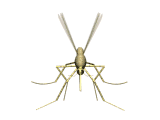 Mosquito Traps - September 10, 2003 Jeff Schalau, County Director, Agent, Agriculture & Natural Resources Arizona Cooperative Extension, Yavapai County Last week's Backyard Gardener column discussed the presence of West Nile Virus in northern Arizona and some mosquito control strategies. Specifically, that column covered mosquito source reduction, larval control (floating "dunks" containing Bacillus thuringiensis israelensis cakes), and the use of mosquito repellents. Source reduction and larval control can be very effective, but some mosquitoes will survive and many people are not comfortable using pesticides. So, lets take a look at some information about mosquito traps and how they work. Most mosquitoes have a preferred host (birds, mammals, humans, etc.). However, if the preferred host is not present, they can and will feed on other less preferred hosts. Most mosquitoes feed on sugary plant nectar or insect honeydew for energy, but the females of many species require bloodmeals to produce eggs. They spend most of the time resting in discreet places, but are activated when they receive host recognition cues. These cues include long-range, midrange, and close-range attractants. Carbon dioxide (CO2) is a byproduct of respiration and serves as a long-range cue. When mosquitoes sense CO2, they follow the plume upwind to its source. As mosquitoes get closer to their host, other cues become more important than CO2. As the mosquito nears its host, it relies more on vision to locate the host. For this reason, light is a midrange cue. Here wavelength of light can also become important as some mosquito species show a preference for various colors and/or ultraviolet light. Human and animal skin odors act as close-range cues for certain species of mosquitoes. In fact, sweat, especially armpit sweat, is a strong attractant for some species of mosquitoes. Research is actually being done to recreate these compounds in the laboratory. Think about it - you could wake up one morning and find you live next to the artificial sweat factory. This could also create new employment opportunities for hygienically challenged individuals. Mosquito traps utilize CO2, light, moisture, heat, sound, and/or volatile compounds (octenol) to attract mosquitoes. CO2 is either generated by the catalytic burning of propane or the slow release of compressed CO2 gas. Once they are attracted, fans pull them either into a net, sticky trap, catch basin, or electric grid. These traps were originally designed for mosquito research, monitoring, and identification. Now, they are available to anyone and range in price from $50 to $1,300. Do these traps work? Consumer Reports tested three different traps using closed rooms. Two species of mosquitoes were released. About 75% of the mosquitoes were recaptured by the CO2 generating traps. Only 25% were recaptured by the trap using sound, heat, and octenol (no CO2). Many other test results are available from different studies-some conducted by manufacturers and some by independent researchers. In a different test, a researcher found improvement in a CO2 trap's effectiveness when it was also baited with dirty socks (the effect lasted for eight days). The bottom line is that traps do reduce the number of mosquitoes in an area, but you are still at risk of receiving bites. CO2 generating traps generally work better than those that do not use CO2. Traps are most effective when used in an integrated pest management (IPM) approach - a combination of strategies that include source reduction, larval control, and careful use of repellents. The information for this article was excerpted from Mosquito Traps and Attractants by William Quarles published in Common Sense Pest Control Quarterly, Vol. XIX, Number 2, Spring 2003. The University of Arizona Cooperative Extension has publications and information on gardening and pest control. If you have other gardening questions, call the Master Gardener line in the Cottonwood office at 646-9113 ext. 14 or E-mail us at mgardener@verdeonline.com and be sure to include your address and phone number. Find past Backyard Gardener columns or submit column ideas at the Backyard Gardener web site: http://ag.arizona.edu/yavapai/anr/hort/byg/. |